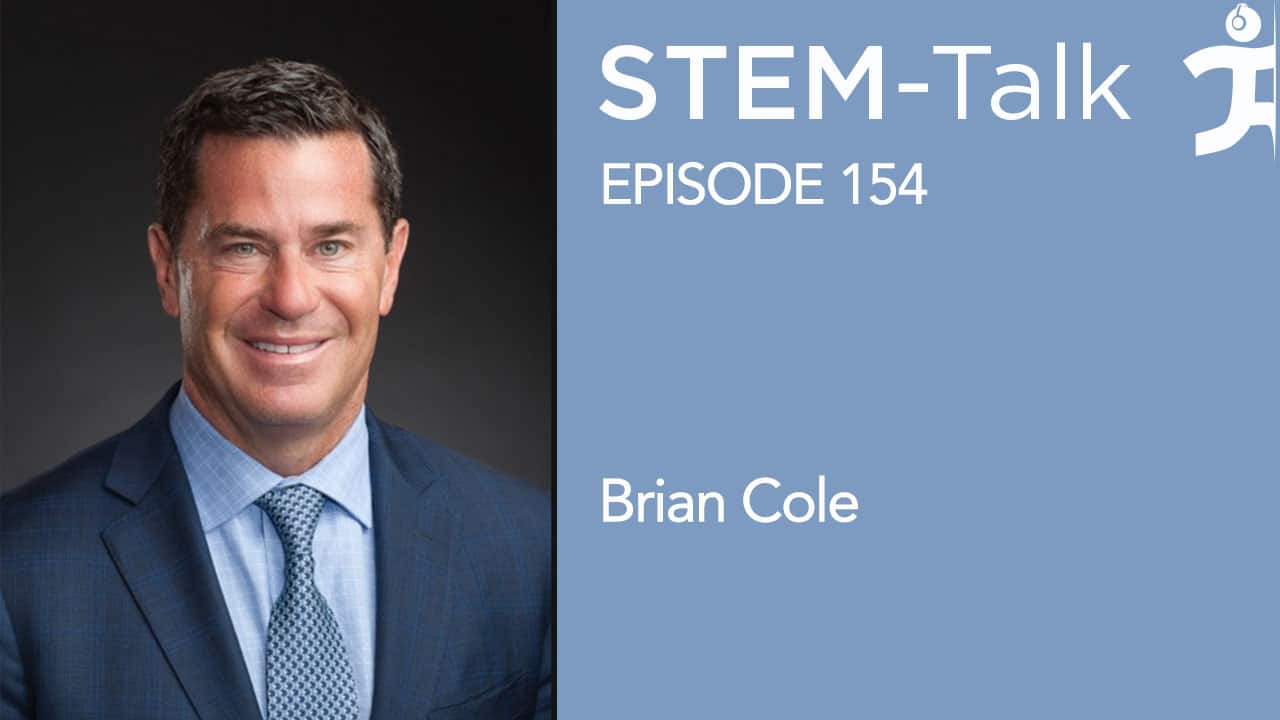STEM-Talk
Episode 154: Orthopedic surgeon Brian Cole discusses advances in the treatment of knee, elbow and shoulder injuries
// Jun 28, 2023

Today we have Dr. Brian Cole, an orthopedic surgeon who specializes in cartilage restoration, orthobiologics, and advanced surgical techniques for the treatment of knee, elbow, and shoulder injuries. He is the team physician for the NBA’s Chicago Bulls and the co-team physician for the Chicago White Sox. He also is the host of the Sports Medicine Weekly Podcast.
Brian practices orthopedic sports medicine at Midwest Orthopaedics. He also is a professor of Orthopaedics, Anatomy and Cell Biology at Rush University Medical Center in Chicago. He is Managing Partner of Midwest Orthopaedics and is the department’s Associate Chairman and the Section Head of the Cartilage Research and Restoration Center. In addition to this work, he also serves as the Chairman of Surgery at Rush Oak Park Hospital.
In today’s interview, we talk to Brian about his cutting-edge research into ways to treat knee, shoulder, and elbow injuries. Brian shares his novel approach to dealing with ACL tears, one of the most common sports injuries, and his investigations of methods to enhance the healing and recovery time following ACL reconstructions. He also talks about new advances in minimally invasive surgical techniques for many common injuries. We have a particularly interesting conversation with Brian about exciting developments in the use of stem-cell treatments as well as the use of bone marrow aspirate to treat injuries.
Show notes:
[00:03:53] Marcas opens the interview mentioning that Brian was in the eighth grade when he fell in love with a popular sit-com from the 1970s, “The Bob Newhart Show.” Marcas asks Brain what he loved about the show and what impact it had on him. [00:05:07] Brian enrolled in the University of Illinois after graduating from high school. Marcas asks Brian if knew he wanted to major in biology and psychology when he arrived on campus. [00:05:58] Ken mentions that after Brian’s undergrad, he travelled upstate to the University of Chicago, where he earned an MD and an MBA. Ken asks what led Brian to pursue both an MD and MBA. [00:09:52] Ken explains that after the University of Chicago, Brian moved to New York City for an orthopaedic research fellowship in metabolic bone disease at the Hospital for Special Surgery. Brian also decided to do his residency there as well. Ken asks how that came about. [00:11:31] Marcas mentions that after Brian finished his fellowship and residency, he went to the University of Pittsburgh for a sports medicine fellowship. Marcas asks what led Brian there and what drove his interest in sports medicine. [00:13:10] Marcas asks Brian about a fortuitous phone call he received when he was a fourth-year resident. [00:14:34] Ken explains that Midwest Orthopaedics is one of the nation’s most respected private orthopaedic practices. Ken notes that through a partnership with Rush University Medical Center, Midwest has developed a national reputation as a leader in sports medicine; hip, knee, spine, and cartilage restoration; as well as shoulder care and pain management. Rush also is an academic medical center that includes a 671-bed hospital and is a center for basic and clinical research. Ken asks Brian to describe the scope of the work that goes on at Midwest and Rush. [00:17:20] Marcas comments that Brian is also the head team physician for the Chicago Bulls and the co-team physician for the Chicago White Sox, and asks Brian to describe some of the work that he does in that capacity. [00:20:09] Marcas explains that Brian treats a wide range of patients with injuries and pain, from athletes to non-athletes, and from children to senior citizens, and that he has performed more than 20,000 surgeries over the course of his career. Marcas asks Brian to give a sense of the patients he sees and what his average day at the office is like. [00:24:00] Ken points out that Brian is known for focusing on treating the patient and not the x-ray or MRI. Ken goes on to say that x-rays and MRIs often bog down both the practitioner and patient with too much information. Brian often refers to this overload as BARF and VOMIT. Ken asks Brian to explain what he means by BARF and VOMIT. [00:31:56] Marcas reflects that a few decades ago, the only way to help someone with the loss of cartilage in the knee was to surgically go into the knee and clean up the debris. Bone on bone pain makes it difficult to walk, get up and down in a chair, and climb stairs. Marcas asks Brian to explain the range of options available to patients today in this regard. [00:35:31] Ken mentions that in the past couple of decades, there have been numerous advancements in how to treat patients with shoulder, elbow, and knee injuries via non-surgical means, ranging from biochemical to pharmacological to diet and rehabilitation. Ken asks Brian to give an overview of these nonsurgical methods and the status of evidence supporting each. [00:39:08] Ken explains that weight loss is often an effective approach to reducing knee pain, and that for every pound a person loses, it leads to a five-to seven-pound reduction at the level of a person’s joints below their waist. Ken asks Brian to talk about the importance of this and how he and others in the practice discuss this with their patients. [00:43:06] Marcas explains that ACL tears often require surgery and are among the most common injuries for athletes and workers in physically demanding jobs, with approximately 500,000 ACL tears each year. Marcas asks Brian to give a sense of what happens to a person when they experience an ACL injury. [00:46:05] Marcas comments that according to the American Academy of Pediatrics, ACL tears have skyrocketed among 14- to 18-year-olds, increasing by 148 percent over the past 10 years. Marcas asks what is causing this increase. [00:48:28] Ken follows up on the previous question mentioning that there is a critical need to develop novel strategies to enhance ACL healing and accelerate recovery time after an ACL reconstruction. Ken goes on to mention that Brian has a study that was designed to assess the effect of bone marrow aspirate concentrate to reduce recovery time and asks about the findings of this study. [00:51:03] Marcas comments that in the late 1900s, cultured chondrocytes implanted beneath a periosteal patch were used as a treatment for chondral injuries. Animal studies had demonstrated hyaline-like repair. Along with encouraging early clinical results, this led to the widespread implementation of autologous chondrocyte implantation, or ACI, in the U.S. and Europe. Marcas goes on to say that many clinical studies supported the long-term efficacy and durability of ACI, but today, scientists are investigating alternative methods of enhancing the biological repair and the surgical technique using ACI. Marcas asks about Brian’s paper – titled “Current Status of Autologous Chondrocyte Implantation” –that recently appeared in Sports Medicine Reports. [00:53:52] Ken asks Brian to discuss meniscal tears, which are the most common pathology of the knee, and one of the most common pathologies in sports medicine. Ken mentions that Brian coauthored an editorial in the Journal of Arthroscopic and Related Surgery that pointed out the most important first step in terms of treatment is determining whether the injury is an acute traumatic tear or a degenerative one. [00:56:11] Ken asks Brian about the use of bone marrow aspirate, or platelet-rich plasma, as a source of growth factors in progenitor cells in rotator cuff repair, a topic on which Brian has a paper coming out highlighting reductions in re-tear rates. [00:58:30] Marcas mentions that Brian has also been involved in a few biomechanics studies looking at fixation of soft tissue to bone and also fixation of soft tissue using sutures, and asks Brian to give a sense of why this work is important. [01:00:31] Marcas explains that current research on osteoarthritis and treatments for it are moving beyond the diseased joint, integrating other articular tissues, including synovium, fibrocartilage, and bone, as well as periarticular structures like muscles, tendons, and ligaments. Marcas asks how this model affects treatment plans. [01:03:43] Marcas explains that until recently, the impact of inflammation on OA pathogenesis was perhaps underappreciated, as OA was not considered an inflammatory disease. He goes on to explain that the field seems to have shifted in this thinking to now include effects of inflammation on periarticular tissues. Marcas asks Brian what his thoughts are on this. [01:08:05] Ken mentions that one of the more promising developments in the field is the use of stem-cell treatments of various kinds, and to this point Ken mentions that there are a number of different approaches. Ken asks Brian to talk about this and perhaps separate fact from fiction on the matter. [01:10:23] Ken asks about cultured stem cells, which are used in treatments for which thousands of Americans travel overseas for each year. Ken asks if there are studies that show increased efficacy in any of these methods. [01:11:29] Ken mentions that Brian also specializes in the treatment of glenohumeral arthritis, which is a degenerative joint disease affecting the shoulder, and is characterized by the degeneration or wearing away of the protective cartilage covering the ends of the bones in the joint. Ken asks Brian to explain what the standard of care is for this disease. [01:13:41] Marcas asks what the average lifespan of a modern shoulder replacement can be expected to be. [01:15:44] Ken asks how reverse shoulder replacement compares to anatomical shoulder replacement. [01:17:10] Ken asks about a 2019 study in the British Medical Journal that reported the risks associated with shoulder replacement surgery for arthritic conditions is much higher than previously thought. Ken explains that the study found that one in four men aged 55 to 59 were at risk of needing further revision surgery, and that the risk of serious adverse events like heart attacks and major blood clots within 90 days of surgery were much higher than previously estimated, particularly in people over 85 years of age. [01:21:29] Marcas closes the interview mentioning that Brian, in addition to his medical practice, is also in the podcast business, hosting a weekly show called “Sports Medicine Weekly Podcast with Dr. Brian Cole.” Marcas asks Brian to discuss the range of topics covered in the podcast.





